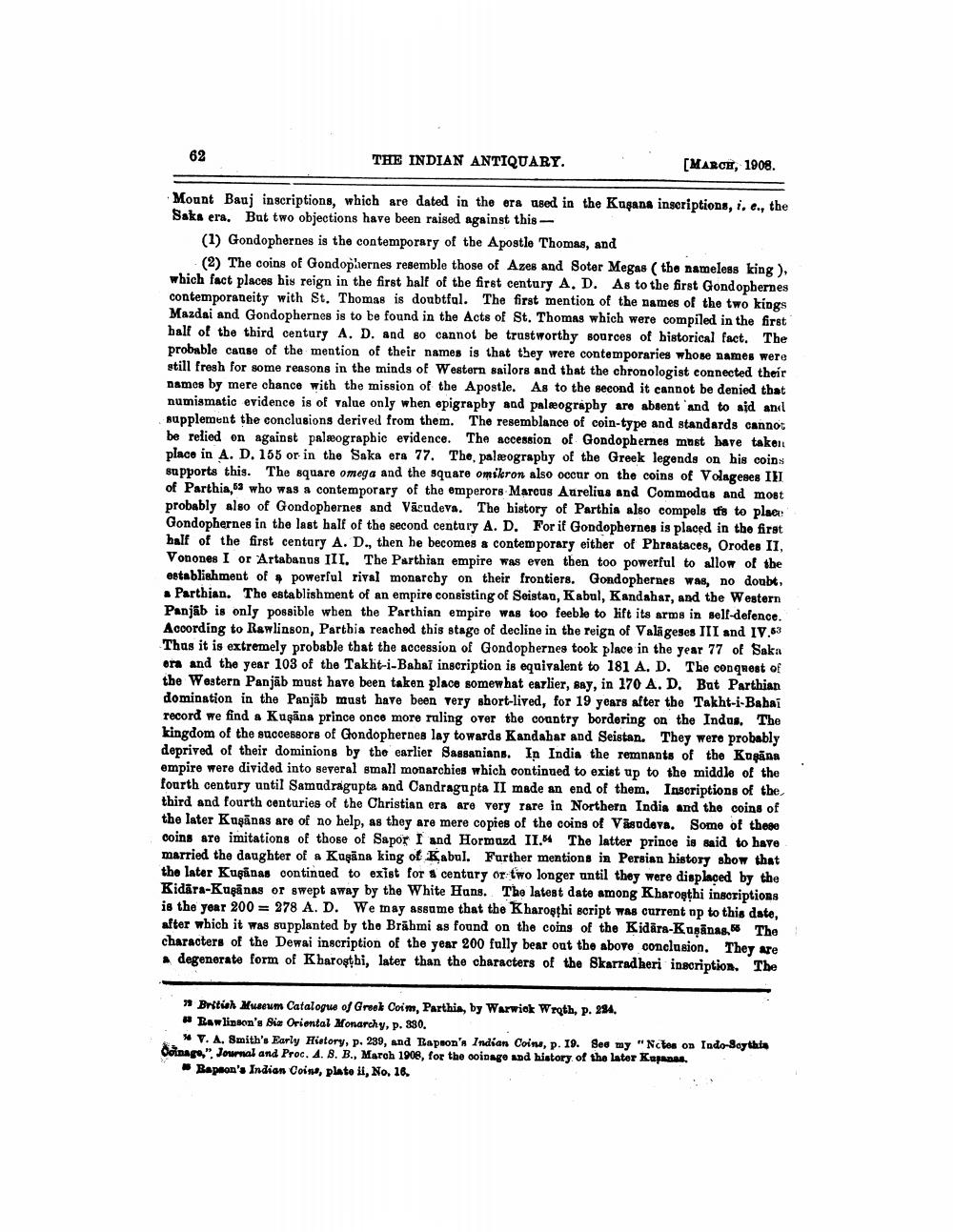________________
62
THE INDIAN ANTIQUARY.
[MARCH, 1908.
Mount Bauj inscriptions, which are dated in the era used in the Kuşana inscriptions, i. c., the Saks era. But two objections have been raised against this
(1) Gondophernes is the contemporary of the Apostle Thomas, and
(2) The coins of Gondophernes resemble those of Azes and Soter Megas (the nameless king), which fact places his reign in the first half of the first century A. D. As to the first Gondophernes contemporaneity with St. Thomas is doubtfal. The first mention of the names of the two kings Mazdai and Gondophernes is to be found in the Acts of St. Thomas which were compiled in the first half of the third century A. D. and so cannot be trustworthy sources of bistorical fact. The probable cause of the mention of their names is that they were contemporaries whose names were still fresh for some reasons in the minds of Western sailors and that the chronologist connected their Dames by mere chance with the mission of the Apostle. As to the second it cannot be denied that numismatic evidence is of value only when epigraphy and palæography are absent and to aid anıl supplement the conclusions derived from them. The resemblance of coin-type and standards cannot be relied on against palæograpbic evidence. The accession of Gondophernes must bave taken place in A. D. 155 or in the Saka era 77. The palæography of the Greek legends on his coins supports this. The square omega and the square omskron also occur on the coins of Volageses IH of Parthia, who was a contemporary of the emperors Marcus Aurelius and Commodus and most probably also of Gondophernes and Vācudeva. The history of Parthia also compels is to placu Gondophernes in the last half of the second century A. D. For if Gondophernes is placed in the first half of the first century A. D., then he becomes a contemporary either of Phraataces, Orodes II, Vonones I or Artabanus III. The Parthian empire was even then too powerful to allow of the establishment of powerful rival monarchy on their frontiers. Gondophernes was, no doubt,
Parthian. The establishment of an empire consisting of Seistan, Kabul, Kandahar, and the Western Panjab is only possible when the Parthian empire was too feeble to lift its arms in self-defence. According to Rawlinson, Parthis reached this stage of decline in the reign of Valâ geses III and IV.53 Thas it is extremely probable that the accession of Gondophernes took place in the year 77 of Saka era and the year 103 of the Takht-i-Bahai inscription is equivalent to 181 A. D. The conqrest of the Western Panjāb must have been taken place somewhat earlier, say, in 170 A. D. But Parthian domination in the Panjāb must have been very short-lived, for 19 years after the Takht-i-Babai record we find a Kuşāna prince once more ruling over the country bordering on the Indus. The kingdom of the successors of Gondophernes lay towards Kandahar and Seistan. They were probably deprived of their dominions by the earlier Sassanians. In India the remnants of the Kuşans empire were divided into several small monarchies which continued to exist up to the middle of the fourth century until Samudragupts and Candragupta II made an end of them. Inscriptions of the third and fourth conturies of the Christian era are very rare in Northern India and the coins of the later Kuşānas are of no help, as they are mere copies of the coins of Väsudova. Some of these coins are imitations of those of Sapor I and Hormazd 11.4 The latter prince is said to have married the daughter of a Kuşāna king of Kabul. Further mentions in Persian history show that the later Kuganas continued to exist for a century or two longer until they were displaced by the Kidāra-Kugānas or swept away by the White Hans. The latest date among Kharoşthi inscriptions is the year 200 = 278 A. D. We may assume that the Kharoşthi script was current op to this date, after which it was supplanted by the Brāhmi as found on the coins of the Kidara-Kuşanas. The characters of the Dewai inscription of the year 200 fully bear out the above conclusion. They are * degenerate form of Kharostbi, later than the characters of the Skarradheri inscription. The
» British Museum Catalogue of Greek Coim, Parthia, by Warwick Wroth, p. 284. # Rawlinson's Bio Oriental Monarchy, p. 330.
V. A. Smith's Early History, p. 239, and Rapeon's Indian Coin, p. 19. See my "Nctes on Tudo-Saythia Ooinaga". Journal and Proc. 4. B. B., March 1908, for the coinage and history of the later Kapanas
- Baphon's Indian Coisa, plate il, No. 16




